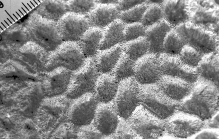
| Intro | | About | | Wiki | | Search traits | | Data explorer | | Literature | | Definitions | | Sources | | Webservices | | Statistics | | Feedback | | Editors | | Log in |
Scleractinia taxon detailsTrigerastraea Alloiteau, 1952 †
1439808 (urn:lsid:marinespecies.org:taxname:1439808)
accepted
Genus
Isastrea trigeri de Fromentel, 1887 † accepted as Trigerastraea trigeri (de Fromentel, 1887) † (type by monotypy)
marine,
fossil only
Alloiteau J. (1952). Embranchement des Coelentérés. Madreporaires Post-Paleozoiques. <em>In: Piveteau J, ed. Traité de Paléontologie, Paris: Masson.</em> 539–684, pls. 1-10. [details]
Hoeksema, B. W.; Cairns, S. (2025). World List of Scleractinia. Trigerastraea Alloiteau, 1952 †. Accessed at: https://www.marinespecies.org/Scleractinia/aphia.php?p=taxdetails&id=1439808 on 2025-05-01
original description
Alloiteau J. (1952). Embranchement des Coelentérés. Madreporaires Post-Paleozoiques. <em>In: Piveteau J, ed. Traité de Paléontologie, Paris: Masson.</em> 539–684, pls. 1-10. [details]
basis of record Cairns, S.D., R. Baron-Szabo, A.F. Budd, B. Lathuilière, E. Roniewicz, J. Stolarski & K.G. Johnson. (2010). Corallosphere. , available online at http://www.corallosphere.org [details]  Present Present  Inaccurate Inaccurate  Introduced: alien Introduced: alien  Containing type locality Containing type locality
From editor or global species database
Comparison Like Dimorphomeandra but forms subplocoid-subcerioid to submeandroid colonies. [details]Diagnosis Colonial, massive, cerio-plocoid, meandroid. Budding predominantly intracalicular. Calices monocentric or arranged in discontinuous series, separated by tectiform to tholiform collines. Ambulacra present or absent. Costosepta generally compact, confluent to nonconfluent. Septal flanks have fine dentations, flattened and rounded granules, and small pennulae. Columella spongy-papillose or made of irregular segments. Synapticulae numerous. Wall parasynapticulothecal, incomplete or absent. Septothecal thickenings present or absent. Endothecal dissepiments abundant. [details] Remark In contrast to the original documentation by Alloiteau (1957, p. 287), the septal structures of genus Trigerastrea seem to be more closely related to types seen in genera like Dimorphomeandra, but correspond less to the genus Vallimeandra. Therefore, the genus Trigerastrea is grouped with the former taxon. [details] |


